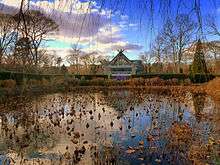Jack Lenor Larsen
Jack Lenor Larsen (born 1927) is a textile designer, author and collector and promoter of traditional and contemporary craftsmanship in all its forms.
Jack Lenor Larsen | |
|---|---|
| Born | 1927 (age 92–93) Seattle, WA, US |
| Nationality | American |
| Alma mater | |
| Known for | Textile design |
Notable work |
|
Early life and education
Larsen was born in 1927 in Seattle, WA to Norsk-Canadian parents. In 1945 he enrolled at the School of Architecture at the University of Washington. The following year he studied furniture design and began weaving, moving to Los Angeles to focus upon fabrics.[1] In 1949 he studied ancient Peruvian textiles in Seattle and opened a studio.[2] In 1951 he earned his Master of Fine Arts degree from the Cranbrook Academy of Art, Michigan, and opened a studio in New York. He currently lives in New York City.[2]
Business
Jack Lenor Larsen, Inc.
Since the 1950s he has designed thousands of fabric patterns and textiles, many associated with the modernist architecture and furnishings popular with post-1945 American consumers.[1][3] In 1952, Larsen founded his firm, Jack Lenor Larsen, Incorporated.[2] In 1951 the interior designer Florence Knoll turned down his textile designs as too "individualistic", but by 1953, she was commissioning olive-green and orange coloured Larsen textiles for furnishings.[1] From the beginning, Jack Lenor Larsen's distinctive hand-woven furnishing fabrics with random repeats in variegated, natural yarns were popular with clients such as Marilyn Monroe.[1][2] In 1958, he designed his first aeroplane upholstery, for Pan American Airlines.[1] His passion for international weaving and textile crafts made him familiar with techniques such as ikat and batik, which he introduced to the American public, and by 1974, Larsen's company was manufacturing fabrics in 30 countries.[4] Since the 1950s the company has commissioned textile designs by artists and designers including Anthony Ballatore, Sari Dienes, Yoshiko Kogo and Timo Sarpaneva.
JL Arbiter Fashion Label
In the late 1950s, Larsen launched a fashion label, 'JL Arbiter', which although successful, was short lived.[5][6]
Textiles for Braniff Airways
In 1968, Larsen designed the interiors and fabrics of Braniff International Airways innovative Terminal of the Future at the Dallas, Texas, carrier's Dallas Love Field hub. He also designed the textiles for use in the interior of Braniff's new Boeing 747 in 1970.[7]
Examples of Larsen's work are preserved in the collections of major museums around the world, and he is one of only two design houses to have been the subject of an exhibition at the Palais du Louvre.[2] Larsen Incorporated merged with Cowtan & Tout, the American subsidiary of the London-based fabric company Colefax and Fowler in July 1997.[2]
LongHouse

Larsen's East Hampton house, "LongHouse", completed in 1992, was built as a collaboration with the architect Charles Forberg, their 30th project together.[1] It is a large house, with 13,000-square-foot (1,200 m2) of floorspace spread across 18 spaces and four floors.[2] The design is inspired by the important Ise Shrine in Japan.[2] The building is raised on stilts, and the spaces are divided by fabric sliding panels that showcase Larsen's fabrics and his collection of historical and contemporary crafts, including works by Lucie Rie, Wharton Esherick, Edward Wormley, and a glass chandelier by Dale Chihuly, whom Larsen encouraged to take up glass-blowing.[1] While the house is not open to the general public, the landscaped sculpture garden surrounding it is regularly open to the public.[2] Sculptures in the garden include works by Willem de Kooning, Sol LeWitt, Bryan Hunt, and Yoko Ono, among others.[8]
Influence
In 1969, Larsen co-curated Wall Hangings, a textile and fiber art exhibit at the Museum of Modern Art in New York.[9] He was a North American Advisor for the Lausanne Biennale.[9] He served as Vice President of Haystack Mountain School of Crafts,[9] and as of 2015 serves as trustee and honorary chairman.[10] In 2015, he was awarded a fellowship of the Textile Society of America.[10]
Selected works
- Fabrics for Interiors: A Guide for Architects, Designers and Consumers (1975)
- Jack Lenor Larsen: 30 ans de creation textile / 30 Years of Creative Textiles (1981)
- Material Wealth (1989)
- Jack Lenor Larsen: A Weaver's Memoir (2003)
References
- Hamilton, William L. (24 September 1998). "At Home With: Jack Lenor Larsen; A Life's Warp and Weft". New York Times. Retrieved 23 April 2009.
- "Jack Larsen". LongHouse Reserve. Archived from the original on 13 April 2009. Retrieved 23 April 2009.
- Renzi, Jennifer (21 October 2007). "Jack Lenor Larsen". New York Magazine. New York Media LLC. Retrieved 31 October 2009.
- "Larsen: a living archive | Introduction". The Minneapolis Institute of Arts. Retrieved 31 October 2009.
- "Pillbox hat, ca. 1957". The Met Collection. New York: The Metropolitan Museum of Art. Retrieved 16 January 2012.
- "Dress, 1960–61". The Met Collection. New York: The Metropolitan Museum of Art. Retrieved 16 January 2012.
- Heller, Karen (June 26, 1988). "Jack Lenor Larsen: Using Fabrics To Give A Space Personality". Philadelphia Inquirer. Retrieved 19 July 2013.
- "LongHouse Reserve Tour". Archived from the original on 30 August 2011. Retrieved 23 April 2009.
- Constantine, Mildred; Larsen, Jack Lenor (1974). Beyond craft, the art fabric. New York: Van Nostrand Reinhold. ISBN 0442216343.
- "Jack Lenor Larsen (2015)". Textile Society of America. 5 January 2016. Retrieved 13 February 2019.
Further reading
- McFadden, David Revere (2004). Jack Lenor Larsen: Creator and Collector. London, New York: Merrell Publishers. ISBN 1858942179.
External links
- Larsen: A Living Archive. Online database of Larsen textiles at the Minneapolis Institute of Arts.
- Jack Lenor Larsen Oral History Project. Transcribed Interviews of Larsen's former designers, employees, and colleagues.
- Jack Lenor Larsen & LongHouse Reserve. Craft in America Visionaries episode (21 December 2018) on PBS.
- An interview of Jack Lenor Larsen conducted 2004 February 6-8, by Arline M. Fisch, for the Archives of American Art
